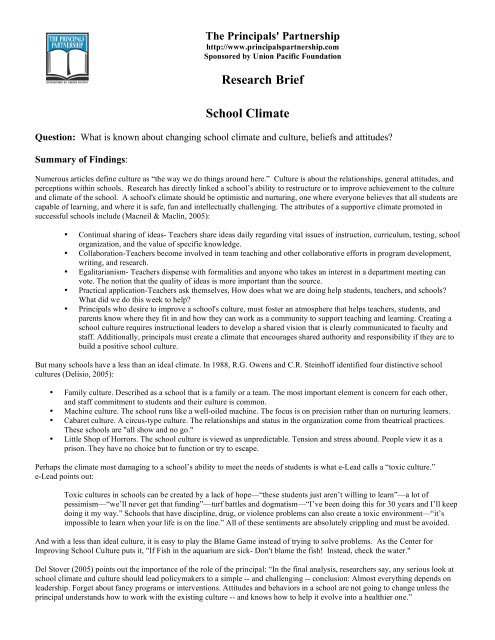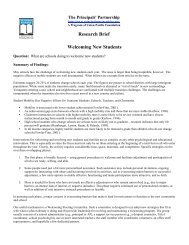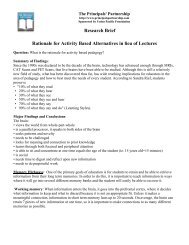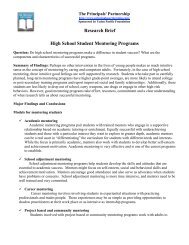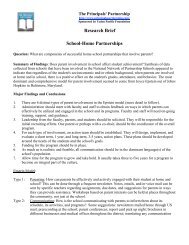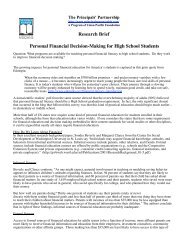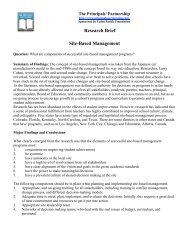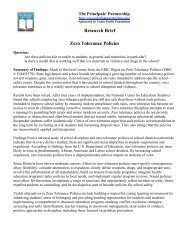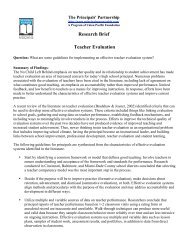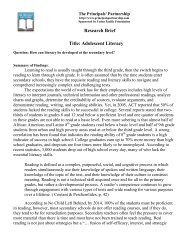School Climate - Online Effectiveness Management Administration ...
School Climate - Online Effectiveness Management Administration ...
School Climate - Online Effectiveness Management Administration ...
Create successful ePaper yourself
Turn your PDF publications into a flip-book with our unique Google optimized e-Paper software.
The Principals' Partnership<br />
http://www.principalspartnership.com<br />
Sponsored by Union Pacific Foundation<br />
Research Brief<br />
<strong>School</strong> <strong>Climate</strong><br />
Question: What is known about changing school climate and culture, beliefs and attitudes<br />
Summary of Findings:<br />
Numerous articles define culture as “the way we do things around here.” Culture is about the relationships, general attitudes, and<br />
perceptions within schools. Research has directly linked a school’s ability to restructure or to improve achievement to the culture<br />
and climate of the school. A school's climate should be optimistic and nurturing, one where everyone believes that all students are<br />
capable of learning, and where it is safe, fun and intellectually challenging. The attributes of a supportive climate promoted in<br />
successful schools include (Macneil & Maclin, 2005):<br />
• Continual sharing of ideas- Teachers share ideas daily regarding vital issues of instruction, curriculum, testing, school<br />
organization, and the value of specific knowledge.<br />
• Collaboration-Teachers become involved in team teaching and other collaborative efforts in program development,<br />
writing, and research.<br />
• Egalitarianism- Teachers dispense with formalities and anyone who takes an interest in a department meeting can<br />
vote. The notion that the quality of ideas is more important than the source.<br />
• Practical application-Teachers ask themselves, How does what we are doing help students, teachers, and schools<br />
What did we do this week to help<br />
• Principals who desire to improve a school's culture, must foster an atmosphere that helps teachers, students, and<br />
parents know where they fit in and how they can work as a community to support teaching and learning. Creating a<br />
school culture requires instructional leaders to develop a shared vision that is clearly communicated to faculty and<br />
staff. Additionally, principals must create a climate that encourages shared authority and responsibility if they are to<br />
build a positive school culture.<br />
But many schools have a less than an ideal climate. In 1988, R.G. Owens and C.R. Steinhoff identified four distinctive school<br />
cultures (Delisio, 2005):<br />
• Family culture. Described as a school that is a family or a team. The most important element is concern for each other,<br />
and staff commitment to students and their culture is common.<br />
• Machine culture. The school runs like a well-oiled machine. The focus is on precision rather than on nurturing learners.<br />
• Cabaret culture. A circus-type culture. The relationships and status in the organization come from theatrical practices.<br />
These schools are "all show and no go."<br />
• Little Shop of Horrors. The school culture is viewed as unpredictable. Tension and stress abound. People view it as a<br />
prison. They have no choice but to function or try to escape.<br />
Perhaps the climate most damaging to a school’s ability to meet the needs of students is what e-Lead calls a “toxic culture.”<br />
e-Lead points out:<br />
Toxic cultures in schools can be created by a lack of hope—“these students just aren’t willing to learn”—a lot of<br />
pessimism—“we’ll never get that funding”—turf battles and dogmatism—“I’ve been doing this for 30 years and I’ll keep<br />
doing it my way.” <strong>School</strong>s that have discipline, drug, or violence problems can also create a toxic environment—“it’s<br />
impossible to learn when your life is on the line.” All of these sentiments are absolutely crippling and must be avoided.<br />
And with a less than ideal culture, it is easy to play the Blame Game instead of trying to solve problems. As the Center for<br />
Improving <strong>School</strong> Culture puts it, "If Fish in the aquarium are sick- Don't blame the fish! Instead, check the water."<br />
Del Stover (2005) points out the importance of the role of the principal: “In the final analysis, researchers say, any serious look at<br />
school climate and culture should lead policymakers to a simple -- and challenging -- conclusion: Almost everything depends on<br />
leadership. Forget about fancy programs or interventions. Attitudes and behaviors in a school are not going to change unless the<br />
principal understands how to work with the existing culture -- and knows how to help it evolve into a healthier one.”
The Principals' Partnership<br />
http://www.principalspartnership.com<br />
Sponsored by Union Pacific Foundation<br />
Research Brief<br />
Positive school cultures can be developed through assessment, analysis, improving and strengthening a school's identity, and then<br />
monitoring progress, said Dr. Wagner of the Center for Improving <strong>School</strong> Culture (CISC). Some schools assess the school culture<br />
as often as four times a year. One way to assess school culture, and then strive to improve it, is through the CISC triage survey.<br />
The survey has 17 questions about school culture, and, based on that, administrators can determine the current condition and<br />
decide whether the culture needs to be monitored or maintained, or whether it needs intensive care.<br />
Attending to a school’s culture does not happen overnight, nor without conflict. According to Rick Dulfour (2004), “Perhaps there<br />
are schools that have made the transition to a professional learning community without conflict or anxiety, but I am unaware of<br />
any. Disagreements and tension are to be expected. The question schools must face is not, ‘How can we eliminate all potential for<br />
conflict as we go through this process’ but rather, ‘How will we react when we are immersed in the conflict that accompanies<br />
significant change’”<br />
<strong>Online</strong> Resources:<br />
The Center for Improving <strong>School</strong> Culture (CISC)<br />
The Center for Improving <strong>School</strong> Culture was developed as a resource to help learning communities assess, analyze and improve<br />
their culture. Educational researchers have established a close and undeniable connection between the health of a school's culture<br />
and student achievement. The health or toxicity of a school's culture has also been linked to staff satisfaction and morale. In an era<br />
of high stakes accountability, we must keep the school's culture healthy and student achievement high<br />
http://www.schoolculture.net/<br />
<strong>School</strong> Culture Triage Survey<br />
By Drs. Christopher Wagner and Penelope Masden-Copas<br />
http://www.education-world.com/a_admin/admin/images/schoolcultureadminimage1.pdf<br />
Leadership For An Improved <strong>School</strong> Culure: How To Assess And Improve The Culture Of Your <strong>School</strong><br />
By Dr. Christopher Wagner<br />
Kentucky <strong>School</strong> Leader; Fall 2004/Winter 2005<br />
http://www.schoolculture.net/kyschoolleaderfall04.pdf<br />
An Audit Of The Culture Starts With Two Handy Tools<br />
By Drs. Christopher Wagner and Penelope Masden-Copas<br />
Journal of Staff Development; Summer 2002<br />
http://www.schoolculture.net/jsdsummer2002.pdf<br />
Leading Edge: Culture Shift Doesn't Occur Overnight--Or Without Conflict<br />
By Rick DuFour<br />
Journal of Staff Development, Fall 2004 (Vol. 25, No. 4)<br />
Culture has been defined as “the way we do things around here.” Leaders shape the norms of behavior (and thus the culture) of<br />
their organizations in a number of ways. When principals work with staff to build processes to monitor each student’s learning and<br />
to develop systems of intervention that give students additional time and support when they experience difficulty, they create the<br />
structures that support the concept of learning for all. When they give staff clear parameters to guide their work but considerable<br />
autonomy in implementation, they increase the likelihood that staff members will embrace that concept. But when principals are<br />
unwilling to tolerate actions that violate the underlying values of the culture, they use a powerful strategy for shaping the norms of<br />
behavior within their school.<br />
http://www.nsdc.org/library/publications/jsd/dufour254.cfm
The Principals' Partnership<br />
http://www.principalspartnership.com<br />
Sponsored by Union Pacific Foundation<br />
Research Brief<br />
Building a Learning Community: The Culture and <strong>Climate</strong> of <strong>School</strong>s<br />
By: Angus Macneil, Valerie Maclin<br />
July 2005<br />
What makes a good school In today's public schools, where diversity is vast and complex, a good school must provide a strong<br />
functioning culture that aligns with their vision of purpose. Good schools depend on a strong sense of purpose and leadership.<br />
However, in order to build a culture that is integral to school life, principals must gear their students, faculty, and staff in a<br />
common direction and provide a set of norms that describes what they should accomplish.<br />
http://cnx.org/content/m12922/latest/<br />
Improving <strong>School</strong> Culture<br />
Article by Ellen R. Delisio<br />
Education World; Originally published 05/03/2005; updated 09/16/2005<br />
What kind of culture pervades your school Do staff members feel like a family Or is it like a factory or a Little Shop of Horrors<br />
One way to assess school culture, and then strive to improve it, is through the Center for Improving <strong>School</strong> Culture's triage survey.<br />
A school's performance never will improve until the school culture is one where people feel valued, safe, and share the goal of<br />
self-improvement, according to Dr. Christopher Wagner, co-director of the Center for Improving <strong>School</strong> Culture.<br />
http://www.education-world.com/a_admin/admin/admin407.shtml<br />
<strong>Climate</strong> and Culture<br />
Why your board should pay attention to the attitudes of students and staff<br />
By Del Stover<br />
American <strong>School</strong> Board Journal, December 2005<br />
Urban school leaders who want to reform low-performing schools usually embark on a series of obvious strategies: strengthening<br />
the curriculum, promoting sound instructional practices, providing more staff training, and tutoring students who need help. But in<br />
this swirl of activity, an important piece of the puzzle is often overlooked: the attitudes and beliefs of students, teachers, and<br />
administrators. Good climate and culture are key to the success of urban schools, according to researchers who’ve spent years<br />
studying the subtle interpersonal dynamics that take place among students and educators. Many are convinced that a closer look at<br />
climate and culture can help urban boards determine why one school is academically successful and -- more important -- why<br />
another is poor performing and consistently failing to improve.<br />
http://www.asbj.com/specialreports/1205SpecialReports/S1.html<br />
Asking the right questions: A school Change Toolkit<br />
McREL offers a wide array of resources related to each component of the school system and each phase of the improvement<br />
process. McREL and its partner laboratories also offer resources related to factors or strategies that research has shown to be<br />
associated with improved student achievement. The <strong>Climate</strong> and culture section includes the advice that school leaders greatly<br />
influence the climate and culture in a school, an influence that is reflected in the relationships between staff, between students and<br />
staff, and even between students. Through their actions and interactions they communicate what is valued and create shared<br />
meaning for the daily work within the school.<br />
http://www.mcrel.org/toolkit/<br />
http://www.mcrel.org/toolkit/res/climate.asp<br />
Creating a Learning-Centered <strong>School</strong> Culture & <strong>Climate</strong><br />
e-Lead<br />
Ideally, all schools will be safe, fun, intellectually challenging places where students explore topics with interest. The reality,<br />
however, is that many schools like to think of themselves as possessing these traits when in fact they do not. When advocating for<br />
a better environment for learning, proponents of reform plans must look at their teaches, the parents, and the people of the school<br />
and put everyone under a microscope. For example, a principal, parent, or teacher that accuses another of being unenthusiastic or<br />
uninspiring is wading into dangerous waters; improving a school’s culture involves improving people and this can be extremely<br />
difficult. Educators that cannot do this, however, put their schools at risk for becoming institutions with a “toxic culture.”<br />
http://www.e-lead.org/resources/resources.aspResourceID=25
The Principals' Partnership<br />
http://www.principalspartnership.com<br />
Sponsored by Union Pacific Foundation<br />
Research Brief<br />
Educational Links: <strong>Climate</strong> and Culture<br />
The South Australian Centre for Leaders in Education (SACLE)<br />
Lots of links and resources on school culture and climate. The South Australian Centre for Leaders in Education (SACLE)<br />
provides high quality professional services to support, challenge and continually strengthen the practice and leadership capability<br />
of educational leaders within the South Australian Department of Education and Children's Services (DECS).<br />
http://www.sacle.edu.au/climate.html<br />
Student Motivation, <strong>School</strong> Culture, and Academic Achievement: What <strong>School</strong> Leaders Can Do<br />
Ron Renchler<br />
This sixth issue of the Trends & Issues series offers an overview of some recent studies of motivation as it operates at both the<br />
organizational and individual levels, especially in an educational context. Students in public schools obviously cannot be given the<br />
immediate financial and professional rewards given to individuals who display high levels of motivation in the workplace.<br />
However, there is a variety of other methods educators can use to awaken and sustain young people’s motivation to learn. The<br />
greatest challenge educators face is to discover what those methods are and to make them an integral part of our educational<br />
system.<br />
http://eric.uoregon.edu/pdf/trends/motivation.pdf<br />
Evaluating <strong>School</strong> <strong>Climate</strong> and <strong>School</strong> Culture<br />
Andrew T. Roach • Thomas R. Kratochwill<br />
http://journals.sped.org/EC/Archive_Articles/VOL.37NO.1SeptOct2004_TEC_Roach37-1.pdf<br />
Submitted Date: 3/6/2006 By: Mike Muir, Maine Center for Meaningful Engaged Learning<br />
http://www.principalspartnership.com<br />
This is provided as a service to educators by The Principals Partnership and Union Pacific Foundation, neither of which assumes any responsibility for the content<br />
of the brief or the positions taken by the authors or the Web sites or other authors whose works are included. This research brief reflects information currently<br />
available and is not the official position of The Principals Partnership or Union Pacific Foundation.<br />
Disclaimer: All URLs listed in this site have been tested for accuracy, and contents of Web sites examined for quality, at the time of addition. Content accuracy and<br />
appropriateness, however, cannot be guaranteed over time as Web sites and their contents change constantly. The author takes no responsibility for difficulties<br />
which may result from the use of any Web site listed herein. Please notify the Webmaster if you find any dead links or inappropriate material.<br />
Permission: You may use or download content for research or educational purposes, or for your personal, noncommercial purposes, provided you keep unchanged<br />
all copyright and other notices with them. No other use of any content is permitted. You agree that you will make only lawful use of this research brief, and will<br />
only use these briefs in compliance with all federal, state and local laws and regulations. You agree that you will make no use of the research that violates anyone<br />
else's rights, including copyright, trademark, trade secret, right of privacy, right of publicity or other rights.


